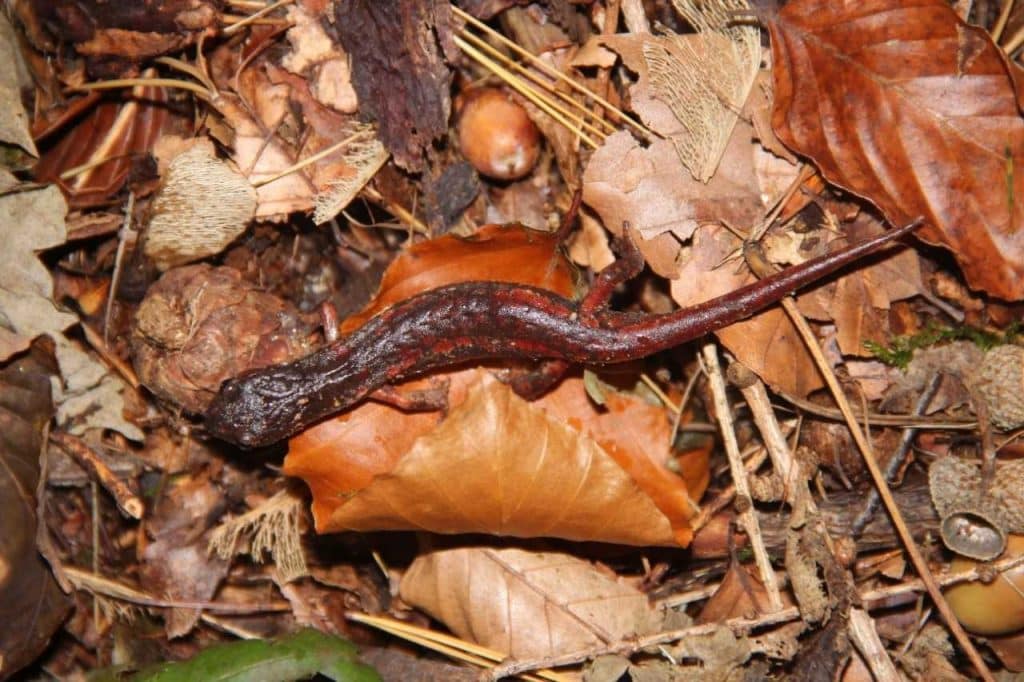Italian Cave Salamanders in Germany?
Non-native species are among the main factors for the loss of biodiversity. For amphibians, especially some frogs and toads (i.e. Cane Toad or African Clawed Frog) have strong negative impact on ecosystems where these species do not belong. In contrast, only few cases are known where salamanders or newts were found in non-native ecosystems.
Cave Salamanders of the genus Speleomantes are endemic to France and Italy, with three species occurring across the Apennine mountain chain on the European mainland and five species on Sardinia. The common name Cave Salamanders is misleading as members of this genus are no obligate cave dwellers. However, Speleomantes are often found in caves but also in other habitats such as mines or crevices, where a moist and cold environment is provided over the whole year. These environmental conditions are necessary for efficient cutaneous respiration as Cave Salamanders are lungless. Since 2013, it is known that an introduced population of Cave Salamanders occur in the Weserbergland/Solling, Lower Saxony, Germany.
However, the identification of Speleomantes based on morphology is difficult and thus the identity of the German population was unknown and studies were lacking. Further, it was unclear if the German population is composed of just a few individuals that persist there for some years or if it is a reproducing, established population. For this reason, the Biologists Philipp Ginal (Zoological Research Museum Koenig in Bonn) and Carl-Henning Loske (Engineer Office Loske) visited the study area several times to collect and photograph the Cave Salamanders. On six capture events during the autumn of last year, the scientists found 70 different individuals of salamanders with only three individuals captured twice. Together with the colleagues Dennis Rödder (Zoological Research Museum Koenig in Bonn) and Thomas Hörren (University of Duisburg-Essen), capture-recapture models were calculated to estimate the population size.
As Cave Salamanders have a unique color pattern when they are adult, an individual identification is possible. Further, a recently published photographic database, comprising more than 1000 images of all eight Cave Salamander species, was used to give a tentative species identification of the German population. Our capture-recapture models estimate a population size between 170 and 485 individuals. Our results show that the German population is much larger than previously expected. However, the minimum estimate of 170 individuals is very unlikely and more realistically the population is much larger than this estimate. Additionally, we found that morphologically only some populations of the species S. italicus were identical to the German population. S. italicus is native to the northern and central Apennines.
Our tentative species identification was already proofed by genetic analyses of colleagues from the University Braunschweig. Further during field work, we could find juvenile Cave Salamanders as well as a pregnant female, which provides evidence for a reproducing population of Cave Salamanders in Germany. As Cave Salamanders are not native in Germany, future monitoring of the German population is required. However, yet the population seems to be restricted to a single rock scarp of c. 40 m length and negative impacts on the native fauna as well as concurrence with other amphibian species could not be observed yet. Sometimes the Cave Salamandes found together with the native Fire Salamanders or Alpine Newts in the same crevices.
Original publication:
Ginal, P., Loske, C. H., Hörren, T., & Rödder, D. (2021). Cave salamanders (Speleomantes spp.) in Germany: tentative species identification, estimation of population size and first insights into an introduced salamander. Herpetology Notes, 14, 815-822.

Caption: A specimen of the small population of cave salamanders in Weserbergland/Solling, Lower Saxony The animals have now been determined as Speleomantes italicus by genetic evidence and external appearance. How the species arrived at this location remains unknown.
